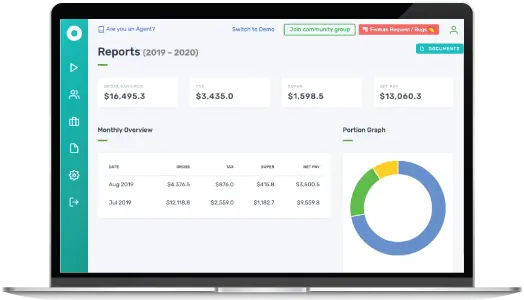Annual leave reports for Australian businesses
Find out how annual leave reports simplify your business’ leave management practices. Review leave reports and foster work-life balance for your employees.
Try Payroller today and say goodbye to payroll and STP headaches!
By clicking Try for Free, you agree to our terms of services and privacy policy.

What is an annual leave report?
An annual leave report is a document that tracks and manages employees’ annual leave entitlements. It includes the following information:
- Individual employee details
- Annual leave entitlements
- Annual leave activity
- Details on leave without pay (LWOP), public holidays, or sick leaves
Benefits of an annual leave report
Efficient leave management
Annual leave reports provide a clear picture of every employee’s leave balances. This allows you to plan for staffing needs when anyone from your team is maximising their annual leave.
Accurate record keeping
While industry standards set leave entitlements for employees, things can get confusing with variables such as LWOP and sick leaves. Having an easy way to view leave balances can prevent future disputes with employees.
NES compliance
According to National Employment Standards (NES), employees earn four weeks of paid annual leave for every 12 months with an employer. Annual leave reports help ensure your business honours the standard.
Types of leave reports
Below are types of annual leave reports that are valuable tools for you to effectively manage employee leave.
Leave transaction report
A leave transaction report focuses on the activity related to employee leave. It provides a detailed record of individual leave transactions within a specific timeframe, typically a month, quarter, or year.
Leave transaction reports typically have the following information:
- Employee details: Name, department, etc.
- Leave type: Annual leave, sick leave, personal leave, etc.
- Date of leave request: When the leave was requested.
- Leave start and end dates: The duration of the leave taken.
- Leave status: Approved, pending approval, rejected, cancelled, etc.
- Leave balance updates: How the leave taken affects the remaining leave balance of the employee.
Leave balance report
A leave balance report focuses on the current state of employee leave entitlements and remaining balances. It provides a snapshot of a specific date, typically at the end of a pay period, month, or quarter.
Leave balance reports typically have the following information:
- Employee details: Name, department, etc.
- Leave type: Annual leave, sick leave, personal leave, etc.
- Leave entitlement: Total leave days employees are entitled to for a specific period.
- Leave accrued: Total leave days earned by the employee within the period.
- Leave taken: Total leave days used by the employee within the period.
- Remaining leave balance: The number of days available for the employees to use
Get staff data at your fingertips and budget efficiently
Annual leave reports are a reflection of your business’ leave management practices. If you are tracking and managing leave usage, you build employee trust and enable them to take breaks with their peace of mind intact.
Having leave data on hand also empowers you to make informed decisions about leave approvals and staff costs. Get onboard with an online payroll software and start reviewing annual leave reports to foster a culture of work-life balance with your employees.
Frequently asked questions about annual leave reports
In Australia, all employees are entitled to annual leave, except for casual employees, employees on fixed-term contracts, and employees on specific visa types.
Per year, full-time and part-time employees are entitled to a minimum of four weeks of paid annual leave. This is based on their ordinary time earnings, which include base salary, wages, and allowances before tax.
Employees accrue annual leave pro-rata based on the hours they work. This means they earn a certain amount of leave for every hour worked. The accrual rate for full-time employees is 10.4 hours per month and for part-time employees, pro-rata based on their contracted hours.
Annual leave loading is a percentage of their gross earnings that are paid to employees on top of standard pay. This is to compensate them for the inconvenience of taking time off work.
For example, an employee earns $1,000 per week (gross) and is entitled to annual leave loading of 17.5%. When they take one week of annual leave, they receive their normal pay of $1,000, plus an additional loading payment of $175 (17.5% of $1,000).
How does Payroller work?
Payroller is designed to make STP simple for small business employers.
Try Payroller for free as an Employer or accounting professional Agent
(accountant, bookkeeper or tax agent).


